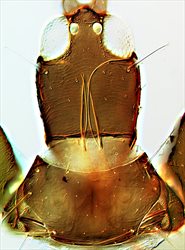
Head & pronotum
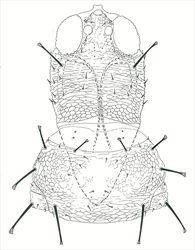
Head & pronotum

Antenna
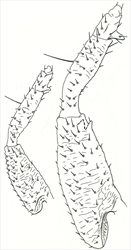
Fore legs of small and large males
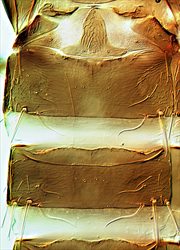
Pelta & tergites II-III
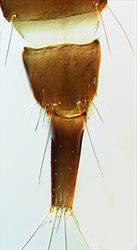
Male tergites IX-X
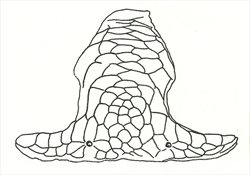
Pelta
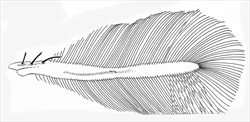
Fore wing
Females fully winged. Body and femora brown, tarsi as well as the bases and apices of tibiae yellow; antennal segments III–VI bicoloured with bases variably yellow; fore wings faintly shaded medially. Antennae 8-segmented, segment III with 3 sense cones, IV with 4 sense cones; VIII narrowed to base. Head longer than wide, wider across convex cheeks than across eyes, cheeks with up to 6 small, stout setae; postocular setae long and capitate, wide apart; maxillary stylets retracted to postocular setae, close together medially. Pronotum without sculpture medially; with 4 pairs of long capitate major setae, anteromarginal setae small; prosternal basantra absent. Fore tarsal tooth well-developed. Metanotum weakly reticulate medially. Fore wing weakly constricted medially, with 10–14 duplicated cilia. Abdominal tergite I, the pelta, elongate with lateral wings, tergites II–VII with two pairs of curved wing-retaining setae; tergite IX setae S1 weakly capitate, more than half as long as tube.
Male similar to female, but postocular setae longer, cheek setae stouter; large males with pair of tubercles on inner apex of fore femora, fore tibiae with tubercle on inner margin; tergite IX setae S2 short and stout; sternite VIII with irregular circular pore plate medially.
There are 117 species listed in Hoplandrothrips from around the world, with nine from Europe of which two are recorded in Britain. Hoplandrothrips bidens and ellisi have been repeatedly synonymised and revalidated as species (Morison, 1947-1949; Mound, 1968); their true relationship remains uncertain. They were most recently separated by zur Strassen (1982a), but the character states that he used do not satisfactorily identify many individuals. Furthermore, there is considerable variation in body size within and between populations, and the associated allometric patterns of growth. Nevertheless, despite this polymorphism, there is a pattern of two dominant sets of character states equating to zur Strassen’s species division. See Hoplandrothrips ellisi for an outline of these distinguishing characters.
Breeding on dead branches, and presumably feeding on fungal hyphae.
Populations and individuals that equate to zur Strassen’s concept of H. bidens have been recorded from Kent and Sussex. Otherwise, widespread across Europe from Norway as far south as Iran.
PHLAEOTHRIPIDAE - PHLAEOTHRIPINAE
Hoplandrothrips bidens (Bagnall)
Acanthothrips bidens Bagnall, 1910: 374
Hoplandrothrips collinsi Bagnall, 1914: 37
Phloeothrips (Hoplandrothrips) tridens Priesner, 1914: 195
Phloeothrips bagnallianus Priesner, 1923: 101
Phloeothrips unidens Priesner, 1923: 101
Phloeothrips parvulus Bagnall, 1927: 584
Phlaeothrips bidens f. simplex Priesner, 1964: 184
Morison GD (1947–1949) Thysanoptera of the London area. London Naturalist, Supplement 26: 1–36; 27: 37–75; 28: 76–131.
Mound LA (1968) A review of R. S. Bagnall’s Thysanoptera collections. Bulletin of the British Museum (Natural History) Entomology Supplement 11: 1–181.
zur Strassen R (1982a) Holz- und rindenbewohnende Fransenflügler (Thysanoptera) an zersägtem Pappelholz im Rheinland. Entomologische Zeitschrift 92: 113–123.